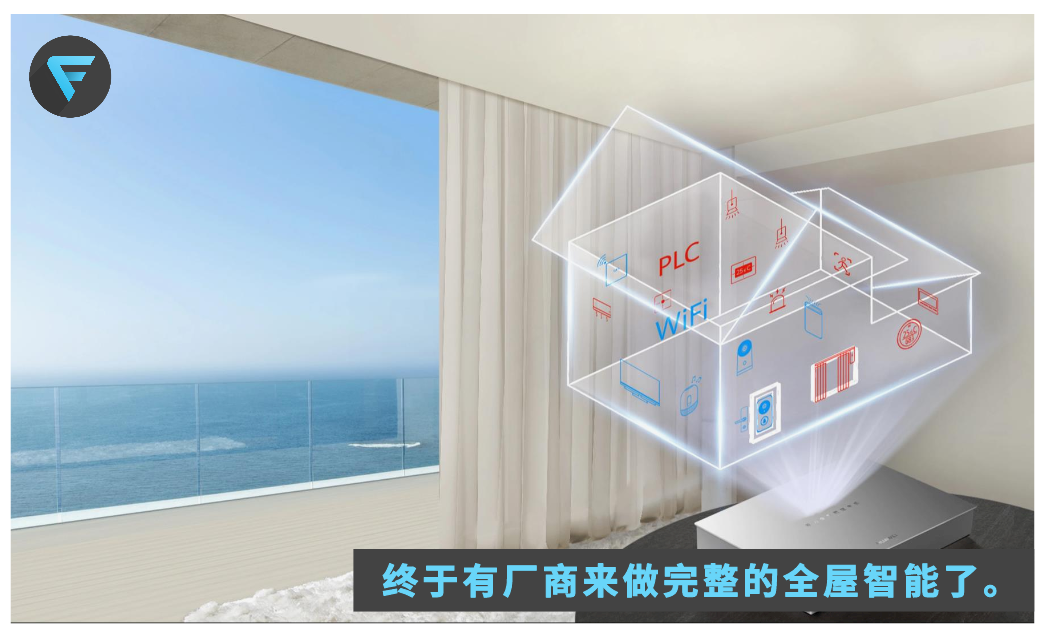 Fengjian (feng_keji) Original Editor | Bai Zhengming Over 20 years ago, when the concept of smart homes was first proposed, the evolution of home appliances and devices was inseparable from the whole-house smart experience. From the active interaction between people and content devices like TVs and controllers, to the passive adjustment of environmental devices like lights, air conditioning, and curtains, smart homes have never been the result of a single device operating independently; they require interconnectivity to form a whole for an upgraded experience. However, the challenge of efficiently and stably connecting devices into a network has remained unresolved, leading to the popular strategy of “single products surrounding the whole family.”
Fengjian (feng_keji) Original Editor | Bai Zhengming Over 20 years ago, when the concept of smart homes was first proposed, the evolution of home appliances and devices was inseparable from the whole-house smart experience. From the active interaction between people and content devices like TVs and controllers, to the passive adjustment of environmental devices like lights, air conditioning, and curtains, smart homes have never been the result of a single device operating independently; they require interconnectivity to form a whole for an upgraded experience. However, the challenge of efficiently and stably connecting devices into a network has remained unresolved, leading to the popular strategy of “single products surrounding the whole family.”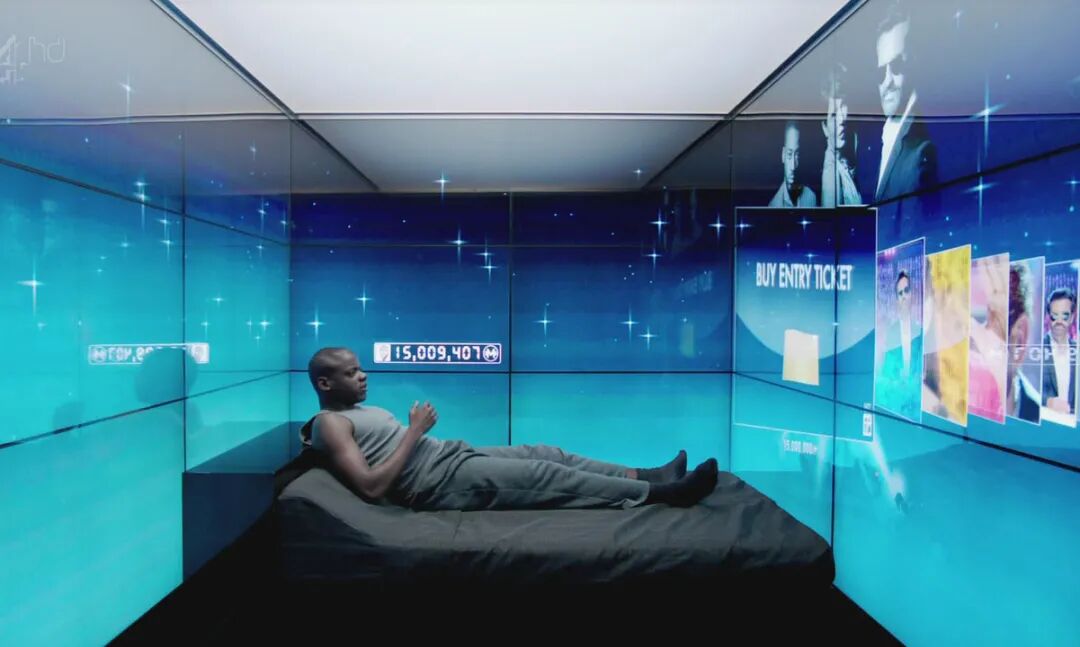 The increasing computing power and manufacturing standards of single devices have led to greater acceptance of smart appliances. With the continuous evolution of wireless network technology, the once-imagined smart home experience, where all devices are interconnected, is finally within reach. Whether it’s long-standing players in the appliance industry or new entrants from the internet era, they have all launched their own whole-house smart solutions.Huawei’s official entry may signify an important development milestone for whole-house smart solutions. This company, which has had a legendary experience in the communications market, has created several leading and impressive products and ecosystems in nearly a decade of competition in the consumer electronics market, with insights and execution that surpass industry averages. What innovations has Huawei brought to this “solution-making” ecosystem?
The increasing computing power and manufacturing standards of single devices have led to greater acceptance of smart appliances. With the continuous evolution of wireless network technology, the once-imagined smart home experience, where all devices are interconnected, is finally within reach. Whether it’s long-standing players in the appliance industry or new entrants from the internet era, they have all launched their own whole-house smart solutions.Huawei’s official entry may signify an important development milestone for whole-house smart solutions. This company, which has had a legendary experience in the communications market, has created several leading and impressive products and ecosystems in nearly a decade of competition in the consumer electronics market, with insights and execution that surpass industry averages. What innovations has Huawei brought to this “solution-making” ecosystem?
 Smart homes also utilize local hosts
Smart homes also utilize local hosts
Unlike most smart homes that place the control center in the cloud, with the local system primarily having network connectivity, Huawei’s whole-house smart center uses a host based on the HarmonyOS, referred to as the “smart brain of the home that integrates learning, computing, and decision-making.” In terms of form, this host can be seen as an ultimate enhanced version of a distribution box, incorporating both network and smart home control. The silver-gray host has reserved spaces for circuit and “optical modem” installation, and the smart home control part is modular in design: the largest part is the central control system, which can provide proactive intelligence for adjusting lighting and water usage based on terminals, sensors, and network data. Next is the PLC control bus and WiFi 6+ router, and users can additionally add storage and music modules as needed.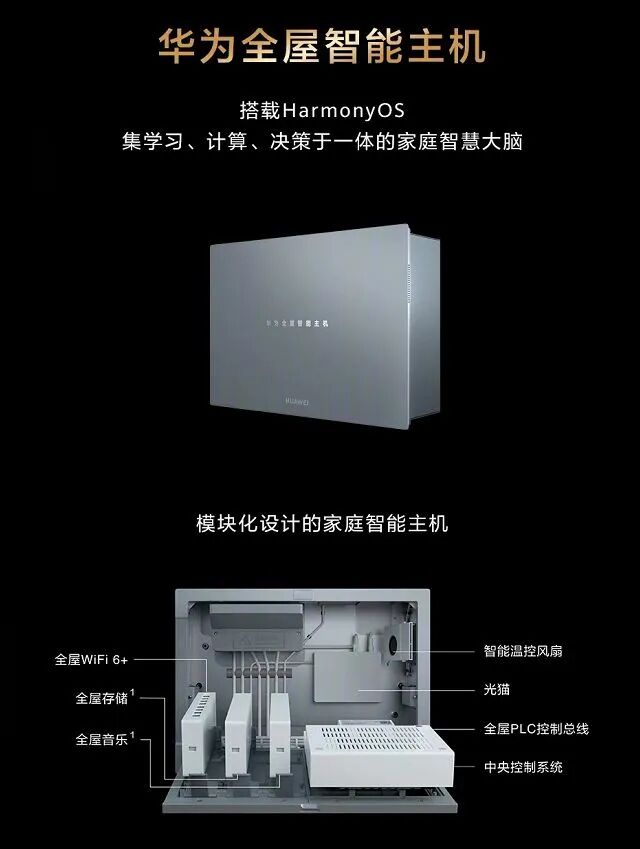 The biggest highlight is the PLC control bus. PLC, or Power Line Carrier technology, aims to achieve stable and reliable wired connections through household wiring. According to Huawei’s official data, PLC can cover 500 square meters, connect up to 384 devices, and maintain over a million hours of uptime without disconnection. Reusing the distribution box and relying on household electrical wiring, Huawei’s whole-house smart solution is clearly suitable for pre-installation, meaning users need to consider the installation connections between the host and various devices during the renovation phase, unlike standalone smart home devices that can be easily installed and used right after purchase. However, pre-installation also offers advantages such as integration with home design and the ability to expand new devices without additional wiring. The whole-house PLC components provided by Huawei are quite basic, including sensors for human presence, gas, temperature and humidity, water immersion, control devices like panels, 86 bottom boxes, and knob remotes, as well as lighting drivers, curtain motors, and HVAC controllers. Since they are connected via electrical wiring and controlled by the host, there is no need to add extra smart modules and network modules, thus controlling installation volume.
The biggest highlight is the PLC control bus. PLC, or Power Line Carrier technology, aims to achieve stable and reliable wired connections through household wiring. According to Huawei’s official data, PLC can cover 500 square meters, connect up to 384 devices, and maintain over a million hours of uptime without disconnection. Reusing the distribution box and relying on household electrical wiring, Huawei’s whole-house smart solution is clearly suitable for pre-installation, meaning users need to consider the installation connections between the host and various devices during the renovation phase, unlike standalone smart home devices that can be easily installed and used right after purchase. However, pre-installation also offers advantages such as integration with home design and the ability to expand new devices without additional wiring. The whole-house PLC components provided by Huawei are quite basic, including sensors for human presence, gas, temperature and humidity, water immersion, control devices like panels, 86 bottom boxes, and knob remotes, as well as lighting drivers, curtain motors, and HVAC controllers. Since they are connected via electrical wiring and controlled by the host, there is no need to add extra smart modules and network modules, thus controlling installation volume.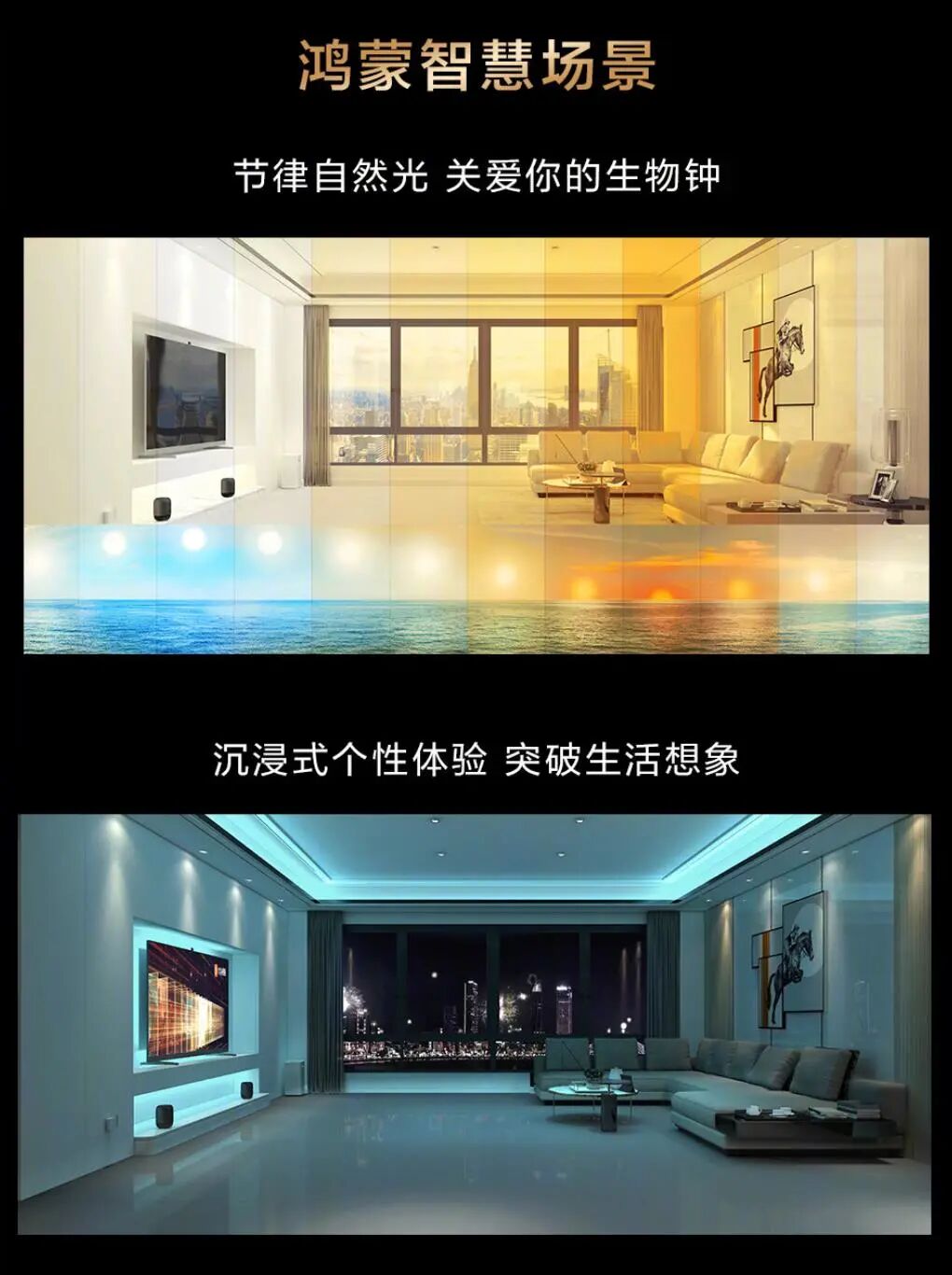 Huawei also hopes that the whole-house smart host can control more scenarios beyond basic appliances, such as lighting, air, water usage, security, audio-visual entertainment, and smart appliances, although this part is not entirely about Huawei creating products themselves, but rather integrating third-party devices that adopt the HarmonyOS, all of which are also managed by the host in the distribution box. Previously, the HUAWEI HiLink brand used for connecting smart devices has been upgraded to HarmonyOS Connect, and mainstream manufacturers of large and small home appliances and smart home products have joined, so consumers need not worry about a lack of options. On the developer side, Huawei also provides reassurance: for example, with Midea, one person can spend seven weeks to complete the integration of home appliances into the HarmonyOS. Relying solely on electrical wiring cannot connect all devices, so Huawei has chosen to use whole-house WiFi 6+ to achieve wireless network coverage. The router is placed in a mother-child router configuration throughout the home, powered via PoE through network cable interfaces, which does not occupy sockets and can achieve seamless roaming with Harmony Mesh+. Compared to ordinary routers building a Wi-Fi Mesh network, this solution aims to minimize user “troubles.”
Huawei also hopes that the whole-house smart host can control more scenarios beyond basic appliances, such as lighting, air, water usage, security, audio-visual entertainment, and smart appliances, although this part is not entirely about Huawei creating products themselves, but rather integrating third-party devices that adopt the HarmonyOS, all of which are also managed by the host in the distribution box. Previously, the HUAWEI HiLink brand used for connecting smart devices has been upgraded to HarmonyOS Connect, and mainstream manufacturers of large and small home appliances and smart home products have joined, so consumers need not worry about a lack of options. On the developer side, Huawei also provides reassurance: for example, with Midea, one person can spend seven weeks to complete the integration of home appliances into the HarmonyOS. Relying solely on electrical wiring cannot connect all devices, so Huawei has chosen to use whole-house WiFi 6+ to achieve wireless network coverage. The router is placed in a mother-child router configuration throughout the home, powered via PoE through network cable interfaces, which does not occupy sockets and can achieve seamless roaming with Harmony Mesh+. Compared to ordinary routers building a Wi-Fi Mesh network, this solution aims to minimize user “troubles.” 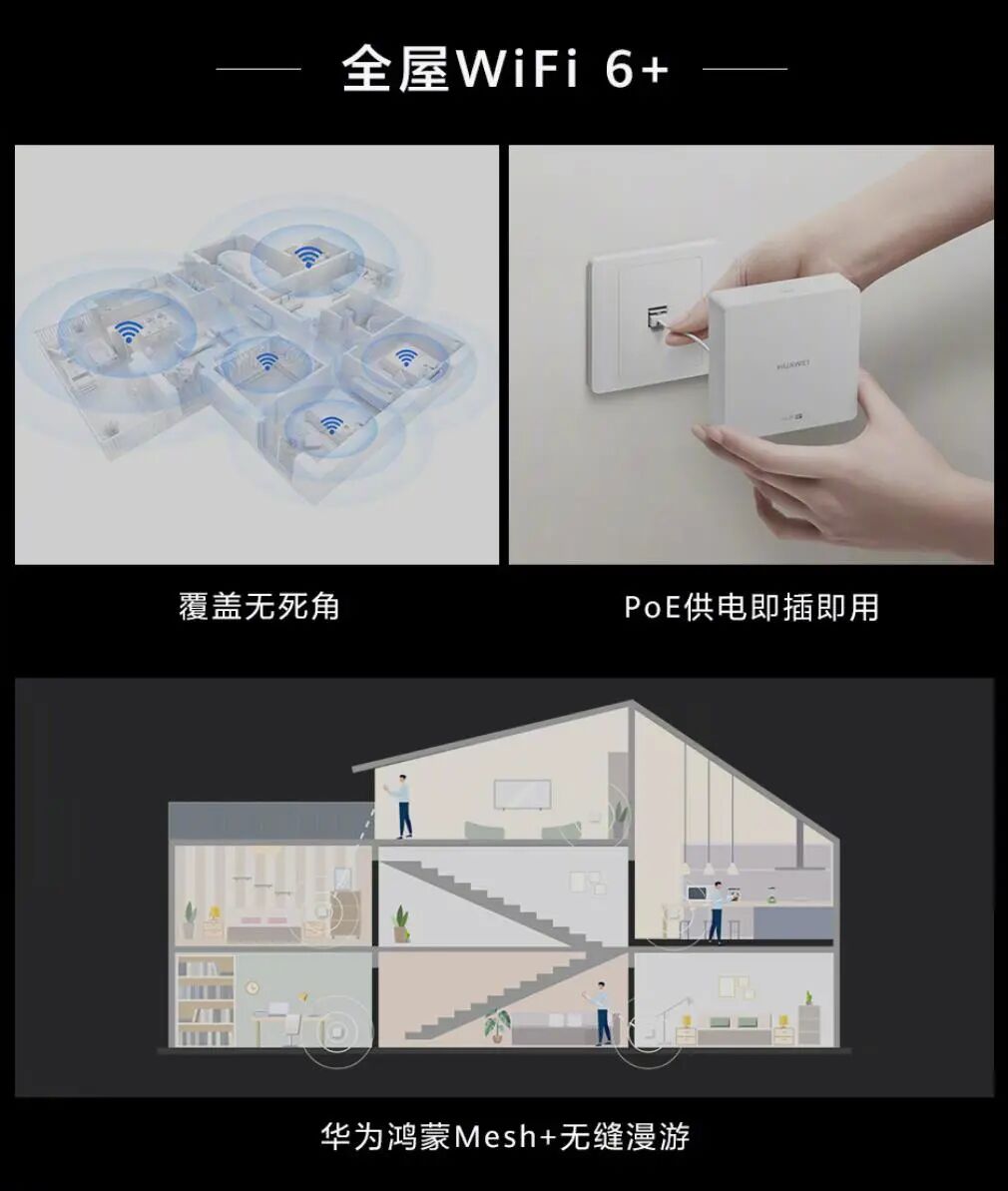 Different sizes of commercial housing make it difficult to have a unified plan and pricing strategy for smart homes, and Huawei’s whole-house smart solution seems to be leading the industry in this regard, offering a starting price of 99,999 yuan for a three-bedroom, two-living-room (approximately 100 square meters) premium version, and 149,999 yuan for a five-bedroom, two-living-room version, both including whole-house status visibility and three hours of on-site service. Prices for smaller units and other versions have not yet been disclosed. Since whole-house smart solutions are still an emerging concept, it is difficult to determine whether Huawei’s pricing has a high premium, but from the perspective of providing a stable experience with a complete package, it is clear that one cannot simply calculate based on the cost of individual components. Huawei plans to start selling whole-house smart solutions between June and August 2021, with offline experience stores in 50 cities across the country in addition to e-commerce, indicating a significant scale.
Different sizes of commercial housing make it difficult to have a unified plan and pricing strategy for smart homes, and Huawei’s whole-house smart solution seems to be leading the industry in this regard, offering a starting price of 99,999 yuan for a three-bedroom, two-living-room (approximately 100 square meters) premium version, and 149,999 yuan for a five-bedroom, two-living-room version, both including whole-house status visibility and three hours of on-site service. Prices for smaller units and other versions have not yet been disclosed. Since whole-house smart solutions are still an emerging concept, it is difficult to determine whether Huawei’s pricing has a high premium, but from the perspective of providing a stable experience with a complete package, it is clear that one cannot simply calculate based on the cost of individual components. Huawei plans to start selling whole-house smart solutions between June and August 2021, with offline experience stores in 50 cities across the country in addition to e-commerce, indicating a significant scale.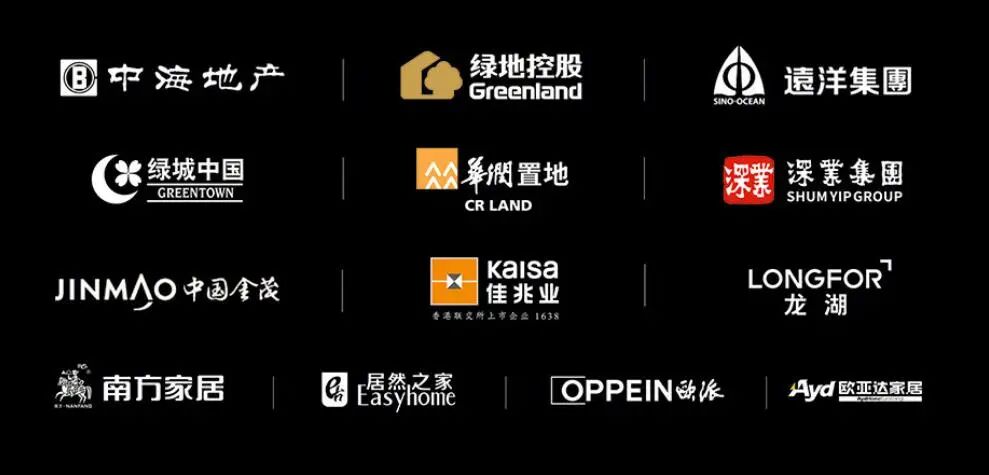 Huawei has also not overlooked the most important customers in the smart home sector, real estate developers, and it is expected that Huawei’s whole-house smart solutions will be seen in high-end properties from China Overseas, Greenland, China Resources, Shen Ye, and Longfor, while also collaborating with home decoration brands like Southern Home, Juran Home, Oppein, and Ouyada. In light of various efforts to expand the pre-installation market, Huawei appears to be quite adept, showing no signs of being a newcomer.
Huawei has also not overlooked the most important customers in the smart home sector, real estate developers, and it is expected that Huawei’s whole-house smart solutions will be seen in high-end properties from China Overseas, Greenland, China Resources, Shen Ye, and Longfor, while also collaborating with home decoration brands like Southern Home, Juran Home, Oppein, and Ouyada. In light of various efforts to expand the pre-installation market, Huawei appears to be quite adept, showing no signs of being a newcomer.
 Smart homes should expand their “circle of friends”
Smart homes should expand their “circle of friends”
Huawei is not suddenly entering the smart home sector; it has shown thought and action since it decided to vigorously expand its consumer business, when products like smartphones began to show promise. Initially, it was HUAWEI HiLink, which, like many contemporaneous manufacturers, used smartphones and routers as connection entry points to connect devices from different partners through an open platform. The IoT version of HarmonyOS continues this idea, using an open-source, cooperative business model to allow Huawei and more manufacturers to operate devices with similar logic and interaction methods, enabling users to connect different devices efficiently and stably, while achieving simplicity and uniformity in interaction through mobile interfaces and voice commands.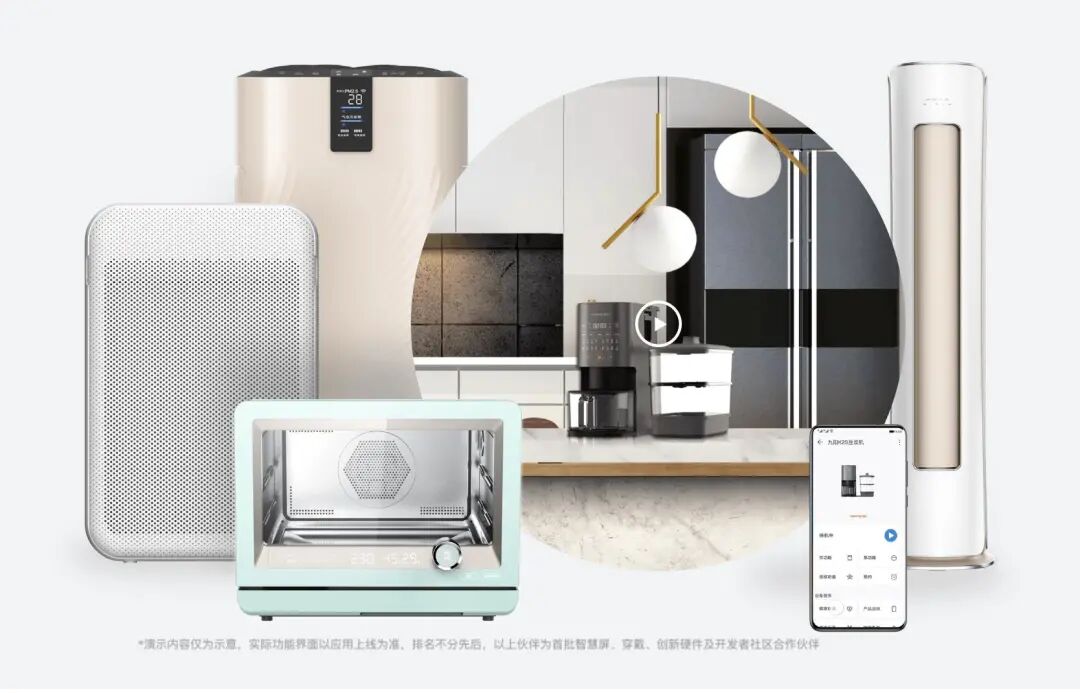 It is evident that Huawei’s whole-house smart solution and the renamed HarmonyOS Connect are continuations of the previous two stages, also based on Huawei’s existing business to create a platform for connecting devices, but with more changes aimed at reducing the cost of using smart homes and enhancing the experience. This addresses some of the industry’s biggest pain points, where after purchasing products, users still need to configure network accounts and strategies, and the usage methods vary between different brands. The existence of the host means that device control no longer relies entirely on cloud services, resulting in lower latency and more responsive operations, while also providing solutions for data security issues. Users can connect their smart homes through Huawei smartphones and other terminals, and the interaction interface and functional logic are highly similar to the mobile operating system, making it relatively easy for even less tech-savvy users to learn how to use it. Users do not need to specifically purchase Huawei-branded smart home products; as long as they use compatible models from various brands that connect to HarmonyOS Connect, they can build a whole-house smart system without information barriers. In fact, the smart home ecosystem products sold in Huawei’s store are not exclusively Huawei-branded, but rather devices produced by various manufacturers after integrating into the ecosystem, often labeled with “Huawei Smart Choice” to emphasize the depth of collaboration.
It is evident that Huawei’s whole-house smart solution and the renamed HarmonyOS Connect are continuations of the previous two stages, also based on Huawei’s existing business to create a platform for connecting devices, but with more changes aimed at reducing the cost of using smart homes and enhancing the experience. This addresses some of the industry’s biggest pain points, where after purchasing products, users still need to configure network accounts and strategies, and the usage methods vary between different brands. The existence of the host means that device control no longer relies entirely on cloud services, resulting in lower latency and more responsive operations, while also providing solutions for data security issues. Users can connect their smart homes through Huawei smartphones and other terminals, and the interaction interface and functional logic are highly similar to the mobile operating system, making it relatively easy for even less tech-savvy users to learn how to use it. Users do not need to specifically purchase Huawei-branded smart home products; as long as they use compatible models from various brands that connect to HarmonyOS Connect, they can build a whole-house smart system without information barriers. In fact, the smart home ecosystem products sold in Huawei’s store are not exclusively Huawei-branded, but rather devices produced by various manufacturers after integrating into the ecosystem, often labeled with “Huawei Smart Choice” to emphasize the depth of collaboration.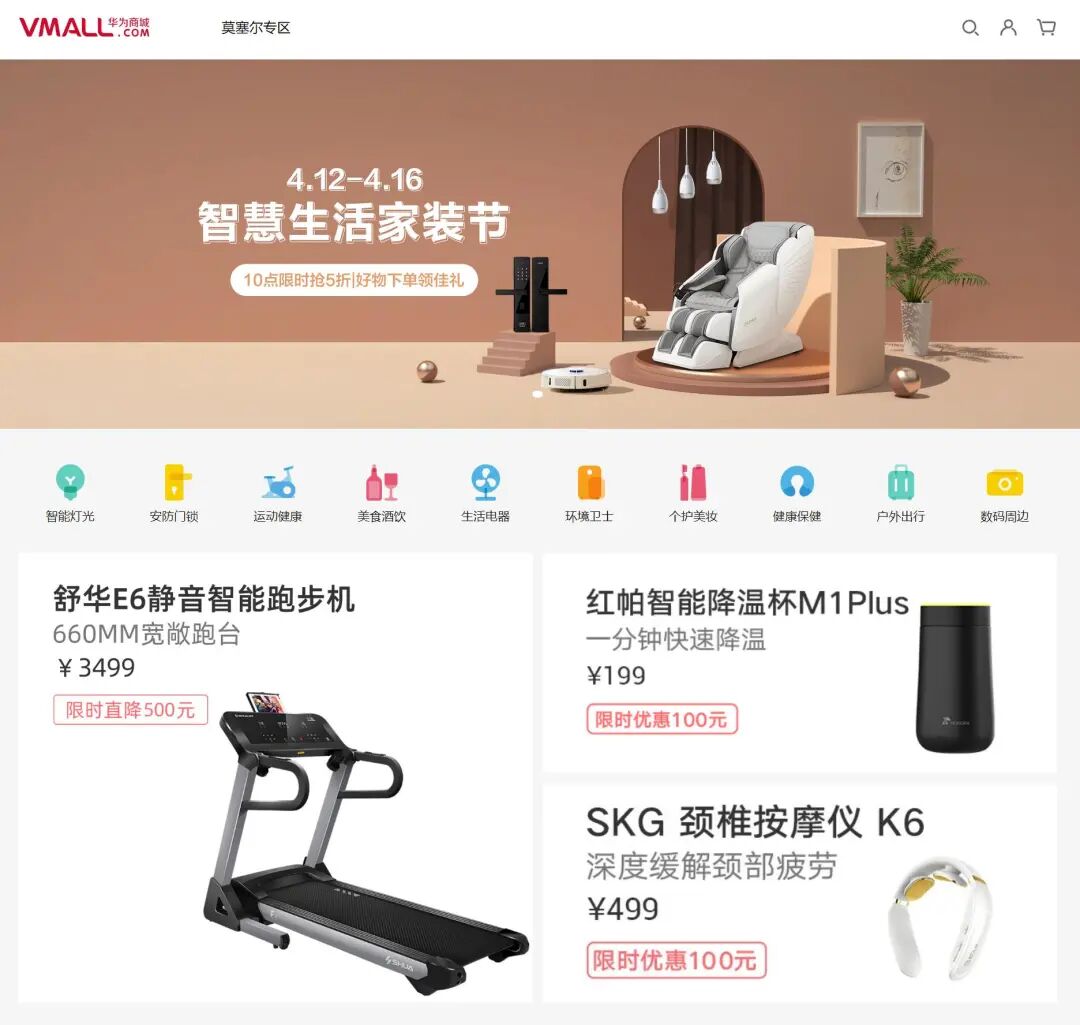 However, whether various large appliance manufacturers can, like smartphone manufacturers, invest in the Huawei Harmony ecosystem from their initially promising operating systems and platforms is another matter. Using third-party platforms allows for a user experience that enables quick access to appliances without additional app installations, but it also cedes control over user entry points and data to others. Balancing the interests between the overall ecosystem and its individual members is not without precedent: Android’s widespread acceptance is due not only to its openness and content ecosystem but also to the fact that Google does not overly restrict manufacturers from operating their own user data. To establish a stronghold in the whole-house smart experience, Huawei must also make decisions as the Harmony ecosystem continues to grow.
However, whether various large appliance manufacturers can, like smartphone manufacturers, invest in the Huawei Harmony ecosystem from their initially promising operating systems and platforms is another matter. Using third-party platforms allows for a user experience that enables quick access to appliances without additional app installations, but it also cedes control over user entry points and data to others. Balancing the interests between the overall ecosystem and its individual members is not without precedent: Android’s widespread acceptance is due not only to its openness and content ecosystem but also to the fact that Google does not overly restrict manufacturers from operating their own user data. To establish a stronghold in the whole-house smart experience, Huawei must also make decisions as the Harmony ecosystem continues to grow.
 Experience + Ecosystem: Is it the Key to Breaking Through in Smart Homes?
Experience + Ecosystem: Is it the Key to Breaking Through in Smart Homes?
If we interpret Huawei’s whole-house smart concept solely from the perspectives of local computing/control centers, scenario-based experiences, and proactive intelligence, we find that these ideas are not new in the smart home industry; almost all major and emerging manufacturers have discussed and attempted to turn these advancements from developer conference presentations into products visible to consumers. However, whether any of these products are truly powerful and user-friendly remains to be seen, as achievements from existing businesses may become obstacles, leading industry players to have their own limitations. Some manufacturers have refined their standalone smart devices well, fully integrating smart and networking capabilities along with account-based management systems, but have failed to improve the whole-house network experience and device interconnectivity, still requiring users to “brutally” replace new routers and not automatically linking data, relying on users to actively set rules, resulting in a high usage threshold.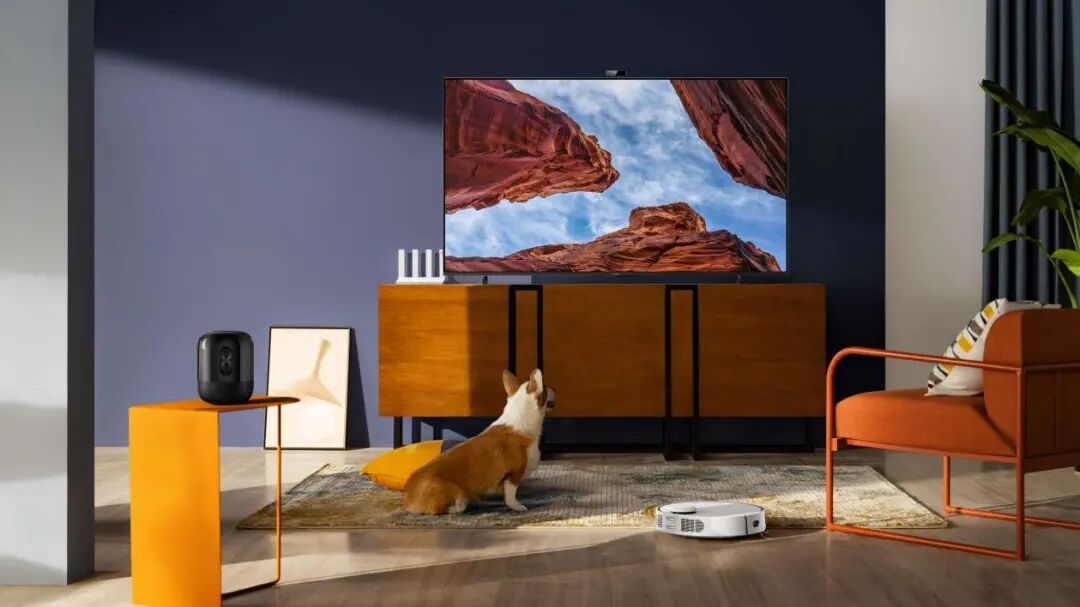 Other manufacturers have a full range of home appliance products and are among the top in their respective fields, actively exploring product intelligence, hoping to provide proactive smart experiences through the combination of multiple appliances. However, their understanding of user experience has always lagged behind that of smartphone and internet companies, making their interaction feel somewhat “dumb” compared to leading smart speakers. Some manufacturers have long recognized the value of local centers and proactive intelligence, aiming to improve safety, functionality, and stability in smart homes, but have been wavering between their own branded products and building platforms. As a result, they have neither expanded their product categories nor established a robust ecosystem capable of attracting more partners, rendering even the strongest host performance ineffective. Huawei’s whole-house smart solution brings a rare glimmer of hope, seemingly providing more reliable solutions to multiple issues at once: household networks covered by both wired and wireless connections, with stability already validated; interaction experiences built on years of expertise, along with a high degree of control over ecosystem products; and a platform that is nearing completion, with a large user base accumulated over the years being a significant asset. Of course, whether Huawei’s performance in smart homes can match the ambition displayed by its products will depend on actual experiences and future advancements. The industry is already aware of related concepts, so it can quickly follow up with similar products, and Huawei’s whole-house smart solution may lose its uniqueness. Whether Huawei can establish a moat for user experience through the Harmony ecosystem and smart interactions will be the key moving forward.
Other manufacturers have a full range of home appliance products and are among the top in their respective fields, actively exploring product intelligence, hoping to provide proactive smart experiences through the combination of multiple appliances. However, their understanding of user experience has always lagged behind that of smartphone and internet companies, making their interaction feel somewhat “dumb” compared to leading smart speakers. Some manufacturers have long recognized the value of local centers and proactive intelligence, aiming to improve safety, functionality, and stability in smart homes, but have been wavering between their own branded products and building platforms. As a result, they have neither expanded their product categories nor established a robust ecosystem capable of attracting more partners, rendering even the strongest host performance ineffective. Huawei’s whole-house smart solution brings a rare glimmer of hope, seemingly providing more reliable solutions to multiple issues at once: household networks covered by both wired and wireless connections, with stability already validated; interaction experiences built on years of expertise, along with a high degree of control over ecosystem products; and a platform that is nearing completion, with a large user base accumulated over the years being a significant asset. Of course, whether Huawei’s performance in smart homes can match the ambition displayed by its products will depend on actual experiences and future advancements. The industry is already aware of related concepts, so it can quickly follow up with similar products, and Huawei’s whole-house smart solution may lose its uniqueness. Whether Huawei can establish a moat for user experience through the Harmony ecosystem and smart interactions will be the key moving forward.
A data cable that raised 10.13 million yuan on the world’s second-largest crowdfunding site, Indiegogo, is quite a concept. The inCharge data cable is the legendary protagonist, featuring a 6-in-1 design that incorporates five common charging plugs into one cable, dubbed the “Swiss Army Knife of data cables.” If you feel overwhelmed by the number of data cables at home, the inCharge 6-in-1 data cable is sure to solve your problem.
Click at the end【Read the original】Receive exclusive coupons for fans🛒 Click to use immediately after receiving
Reproduction in any form is prohibited without permission.
———Recommended Reading———


Remember to share, like, and follow for a triple treat~